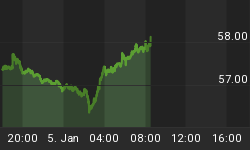The gold sector of the stock market has, over many years, exhibited a strong tendency to reach an extreme during the October - November period. For example, the below table indicates that gold stocks (as represented by the XAU) have made either an important low or an important high during October-November in 9 of the past 12 years and in each of the past 7 years. Furthermore, 3 of the 4 highs have occurred in October and 4 of the 5 lows have occurred in November.
| Year | Extreme (High or Low) |
| Oct-Nov 2003 | High (Nov)* |
| Oct-Nov 2002 | Low (Oct) |
| Oct-Nov 2001 | Low (Nov) |
| Oct-Nov 2000 | Low (Nov) |
| Oct-Nov 1999 | High (Oct) |
| Oct-Nov 1998 | High (Oct) |
| Oct-Nov 1997 | High (Oct) |
| Oct-Nov 1996 | - |
| Oct-Nov 1995 | Low (Nov) |
| Oct-Nov 1994 | - |
| Oct-Nov 1993 | - |
| Oct-Nov 1992 | Low (Nov) |
*In 2003 the actual closing high for the XAU occurred on the second trading day of December
The above-described gold stock seasonality suggests that the October-November period this year will provide us with either a major peak or a major trough. But which will it be?
In our 21st July commentary and in many subsequent commentaries we've argued that this year's October-November turning point would probably be a low. Specifically, our view has been that a rally into September would likely be followed by a successful test of the May low during November, after which the next upward leg in the secular bull market would get underway. This scenario has appealed to us because it meshed with our intermediate-term dollar view and the likelihood that we'd get a traditional October low in the stock market (when gold stocks move higher with the broad stock market as they have done since October of 2002 they will usually get dragged down if the broad market takes a big hit). However, as we approach the second week of October we have: a) the US$ still within its multi-month consolidation range, b) the stock market displaying a few signs of strength, and c) gold stocks making new recovery highs. As such, the probability is increasing that this year's October-November extreme will be a high rather than a low.
In our opinion, the odds of an important October-November low remain slightly better than the odds of a high. Clearly, though, if the major gold stocks continue to make new recovery highs after the middle of October then the odds will shift decisively in favour of the October-November turning point being a high. Such an outcome would provide some near-term excitement for the owners of gold stocks, but would be a bearish omen for the ensuing 12 months because in previous cases when the October-November turning point has provided a high the gold sector has trended lower over the ensuing 6-12 months.
Of course, it is quite possible that the above-described seasonality will not 'work' this year. In fact, we would never blindly assume that any seasonal/cyclical influence was going to work during any given year. Instead, our goal is always to have a rough road map in mind but to make investment/trading decisions based on a real-time analysis of ALL the main factors that affect the markets we follow. For instance, regardless of the direction in which well-worn seasonal effects were pointing we don't think it would make sense to turn intermediate-term bearish on the gold sector if the HUI/gold ratio was trending higher but had not yet reached an overbought extreme (as measured by our HUI/Gold Oscillator).
The bottom line is that although we wouldn't defer to seasonal/cyclical factors it's a good idea to be cognizant of them; especially in those cases when they have proven to be reliable over many years. That way, if other indicators do 'confirm' the seasonality then we will have a better idea of what to expect over the ensuing months/quarters.















